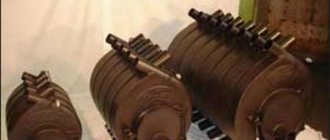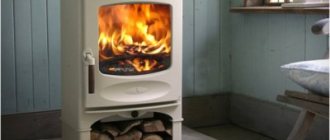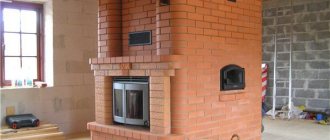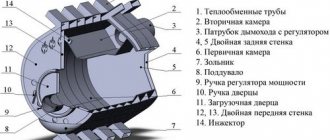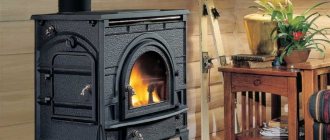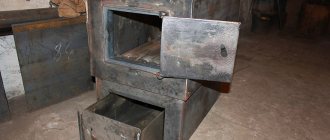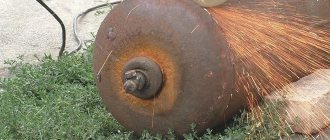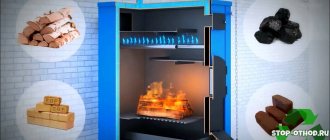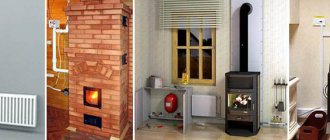How does a wood stove work?
Long-burning stoves for heating a house differ from the classic one in that they have a two-chamber device. Here, solid fuel first smolders, then the resulting products burn. This way, virtually no soot remains and the maximum possible amount of thermal energy enters the room.
Upon closer examination, the working process of the unit looks like this:
- firewood flares up in the upper part of the stack;
- conditions are created for fuel smoldering;
- pyrolysis gas burns out.
Pyrolysis or gas generation is the process of decomposition of fuel heated to combustion temperature. The main condition here is the presence of oxygen in the required volume for smoldering, but not enough for an open flame. Based on this phenomenon, ovens are also called pyrolysis ovens.
Staged combustion of fuel
The design of the furnace allows you to create conditions for the release and combustion of pyrolysis gas through two channels for air supply. They are located in each chamber. That is, the following actions are performed in turn:
- Fuel is added until the chamber is completely filled (in the case of firewood, large logs are placed down and chips are placed on top);
Laying firewood in a pyrolysis oven Source kak.znate.ru
- a channel opens to supply primary air to the firebox;
- the bookmark is ignited in the upper part until red coals and an open flame are formed, the minimum required temperature inside the chamber is reached at +250-+300 degrees Celsius;
- the door is closed, the air channel into the firebox is first partially closed to ensure the smoldering state of the fuel with its additional drying, then it is completely closed,
- the supply of oxygen to the upper chamber opens for afterburning of the released products at a temperature of about +400-+450 degrees Celsius.
Pyrolysis gas contains methane and carbon monoxide. The heated mass, after unlimited supply of secondary air into the upper chamber, ignites. This afterburning process is accompanied by the release of a large amount of thermal energy. The soot here burns almost completely, and the residual products go into the chimney.
As a result, in a long-burning stove, the fuel decomposes, releasing heat twice. This approach allows you to increase the efficiency of the heating device.
Staged combustion of fuel Source kotel-tverd.sot.kg
Here, wood or coal burns almost completely for more than 1-2 hours, as happens in a traditional single-chamber stone stove. Here, one bookmark is enough for 6-12 hours, which is not a limitation for developers in order to expand the range. Modern units can operate for up to 20 hours or up to 3 days.
Equipment efficiency
In a conventional stone firebox, fuel combustion occurs in a single stage and quickly. Decay products go into the chimney or remain in the form of ash. That is, the product does not burn completely. As a result, the efficiency here is approximately 40%. If the chimney is extended around the perimeter of the room, the indicator will increase slightly, but will increase.
Regular stove Source 1-teplodom.ru
In a two-chamber device, maximum combustion occurs first of solid fuel, then of the released pyrolysis gas. In both cases, thermal energy is released. A small part of the flow goes into the chimney, the rest is spent on heating the room. Thus, the efficiency or efficiency of a slow burning stove reaches 90%.
Since not all units are highly energy efficient, users are looking for solutions to increase efficiency on their own. The solution may be forced air circulation. This way the thermal energy will spread faster throughout the house.
The other option is more expensive and time-consuming. Here a sealed heat exchanger under water is mounted on the chimney. The efficiency of a stove with a water circuit will be increased due to hot water pipelines extending from the device.
Equipment with a water heat exchanger Source brat.teplozhar.ru
The third solution option can be implemented independently or you can consider ready-made proposals from the manufacturer. This is a ceramic cladding that helps to prolong the preservation and release of thermal energy. This is justified by a lower thermal conductivity coefficient compared to metal, which additionally ensures the safety of users (it does not burn, as it does not heat up to a dangerous degree). In addition to the heat-accumulating ability, it is worth highlighting the aesthetic side. Tiles can have different colors, patterns, and textures.
Adjustments to the stove operating mode set by the manufacturer are also made if the fuel burns out too quickly or for a long time. Experts recommend entrusting the solution of such problems to representatives of the manufacturer or service company. A do-it-yourself approach can aggravate the situation, which often leads to equipment replacement.
How to make a stove for a greenhouse with your own hands?
Materials and tools
To construct a stove for heating a greenhouse yourself, you will need the following materials and tools:
- A cylinder made from sheet steel, an old metal drum, or a used gas cylinder. This article is based on a used barrel with a capacity of 200 liters.
- A metal pipe of at least 15 cm in diameter for smoke removal, metal corners.
- Grinder for working on metal with suitable discs.
- Electric welding machine.
For the operation of the stove, firewood and wood waste, coal, pellets, briquettes and even household waste are suitable as fuel. Typically, one load requires at least 5 kg of fuel material for combustion. Firewood or other suitable fuel should be stacked tightly so that it does not have to be thrown while the sawdust is smoldering.
Scheme
The figure below shows a diagram of a long-burning stove for a greenhouse consisting of one barrel:
Before you start making the unit, you need to understand the principle of its operation:
- Cold air will enter through a pipe at the top of the structure. Fuel placed in the stove will smolder slowly due to reduced access to oxygen.
- Moreover, such a system will produce more heat than during combustion.
- Sawdust is mainly used as fuel for smoldering - one of the cheapest combustible materials.
- Fully loading a homemade stove is often enough for the heat production process to last from 8 hours to 1 day.
Having understood the design features of heating devices and carefully studying their drawings, you can assemble the simplest stoves for greenhouses in 1 day. If there are any doubts that making a stove for a greenhouse yourself is not a difficult task, experienced hobbyists recommend contacting a specialist who will teach you how to properly install a chimney, carry out welding work, or recommend where it is best to place the device.
Assembly algorithm
Designing a stove for a greenhouse is not difficult, you just need to follow these steps:
- If the barrel is solid, cut off the top part and process the edges. The cut disk will later be used as a press.
- Make a hole on the side of the upper part of the barrel for the chimney, corresponding in diameter to the size of the pipe.
- At the bottom of the barrel, cut a rectangular hole for storing firewood.
- We recommend making a retractable structure to make it convenient to get rid of ash. If there is no such blank, then simply build a door that will ensure a tight closure and sufficient tightness of the device.
- Weld a cone from a sheet of metal with an upper diameter of about 12 cm and a lower diameter of 7-8 cm.
- Install a horizontal perforated partition with a hole in the middle above the level of the firewood door. The hole in the partition should fit the bottom of the cone made from a metal sheet. Firewood will be located in the lower part of the stove, and sawdust will be located in the upper part.
- From the cut off upper part, make a future press disk of smaller diameter than the diameter of the barrel so that it fits easily into it. Make the press heavier by welding metal parts to it. When the sawdust in the barrel begins to smolder, the press will move lower under its own weight, preventing the access of oxygen. Cut a small hole in the middle of the press disk and weld a blower pipe.
- We weld the chimney pipe.
- Weld corner legs to the bottom of the barrel for structural stability.
Addition:
Quite popular is a structure consisting of two barrels of different diameters, welded together at the bottom at a distance sufficient to accommodate firewood. In this case, sawdust is poured into the inner barrel.
The structure of a furnace assembled from two barrels and its proper use is shown below:
Typical wood burning device designs
Heating equipment is available in different designs. Two-chamber units can additionally be used for cooking and arranging a home heating system with water radiators.
Connecting a radiator to a pyrolysis furnace Source gidroguru.com
There are models that fit perfectly into the interior of a private home - long-burning fireplaces.
Basic
The range of single-function stoves is wide, but all models have a common design solution. This is a hollow metal body with technological holes for channels and openings for doors, internal partitions between the chambers and the ash pan.
Let's look at some design features:
- the bottom of the body is represented by a small compartment, the ash pan is separated from the firebox by a grate;
- for solid fuel, the chamber occupies most of the internal space of the unit;
- the upper afterburning chamber of pyrolysis gas has the shape of a dome;
- the channel for supplying primary air is analogous to the ash pan and/or ash pan in a traditional single-chamber furnace;
- camera doors are often made with a heat-resistant glass insert for visual control of what is happening inside the device, which adds aesthetics;
- smoldering of solid fuel occurs towards the second chamber;
Operation of a wood-fired pyrolysis heating boiler Source strojvodproekt.ru
- the air here takes part not only in the ignition and afterburning of peroxide gas, but in the cooling and self-cleaning of the sash (a small gap is provided above it for its further passage into the firebox);
- the chimney pipe has a cross-sectional diameter of 80-150 m;
- The doors in the side wall of the case are used for cleaning the compartments; they have a solid design without inserts.
Operation of the equipment is allowed in two modes. To quickly heat a room (for example, a country house), the operating mode involves extending the damper on the chimney, open access to primary air. The second option is relevant for long-term heating of a building by maintaining a constant air temperature. This is achieved due to the smoldering of fuel and the combustion of pyrolysis gas.
Mode of ignition or quick heating of the room Source yandex.net
See also: Catalog of companies that specialize in the design and installation of fireplaces and stoves
With water circuit
Such furnaces are designed to serve houses with a large area and several isolated rooms. Such designs make it possible to solve the problem of heating the entire facility with one device. The design feature here is that the water heat exchanger is built into the furnace body. There are also 2 pipes for inlet and outlet of coolant.
Long-burning stoves with a water circuit consist of compartments and channels, partitions, and a housing with doors similar to the basic version. The design solution of the heat exchanger of the heating device is presented as follows:
- sealed layers of water along the walls, upper part of the body, partitions between combustion chambers;
- water “jacket” on the sides and above the combustion chamber;
- grate made of circuits with water (allows you to use the heat that is released during smoldering of the fuel).
Scheme for a homemade pyrolysis boiler Source oboiman.ru
Flanges or couplings for threaded connection of the heat exchanger with supply and return water pipes from the water heating system of a house with radiators (in the area of the ash pan and the upper part of the furnace). Additional cooling elements can be built into the heat exchanger. A number of models have a thermal insulation layer inside the body to prevent burns, overheating and spontaneous combustion of surrounding objects or decorative trim. If this is not provided, then the unit itself becomes not only a source of heat, but an element of the heating system of the house.
Long-burning furnaces with a water circuit
Long-burning heating stoves with a water circuit will be the best heating option for a home if it is not possible to supply gas to it, and electric heating is too expensive.
Such heating devices not only allow you to increase the interval between fuel loads, but also make it possible to heat several rooms or the entire house at once.
Heating stoves with a water circuit are universal devices for heating rooms, combining the functions of a boiler and titanium. These stoves are the optimal choice for heating country houses and cottages.
In heating stoves with a water circuit, the heat exchanger is built into the chimney duct or firebox. Some types of furnaces operate in hot steam circulation mode, which is not available in a standard hot water circulation system.
This design is designed to solve problems with providing heat in houses that require autonomous heating. Due to the fact that water actively circulates in various heat exchange systems, for example, in radiators, several rooms can be heated at once.
As a result, the entire house is heated. In addition, using a stove with water heating allows you to significantly save on wood, and the room warms up very quickly.
It is worth remembering that if you do not heat this stove in severe frosts, then there is a high probability of the coolant freezing, and this can happen very quickly.
Therefore, if no one lives in a house with such a design on a permanent basis, experts advise adding special additives to distilled water. Thanks to them, the system will not freeze.
Such heating stoves may differ in the material they are made of. So they could be:
- metal - steel or cast iron;
- brick;
- combined - when a ready-made metal firebox with a heat exchanger for the water circuit is used as a basis, and the outer casing is made of brick.
Advantages and disadvantages of water-heated furnaces
Main advantages:
- Available fuel. If necessary, firewood can be collected on your country plot.
- Small sizes.
- Easy to operate and maintain.
- Firewood is considered an environmentally friendly raw material that is not capable of causing harm to the human body. When they are burned, a minimal amount of harmful substances is produced and released into the environment.
- Relative autonomy. In the absence of electricity, a water-heated structure will heat the room for a long time with its hot body.
- For the manufacture of wood-burning stoves, materials are used that are characterized by increased strength. This allows the structure to serve for a very long time, practically without undergoing repair.
- In addition, such a design for the home may have a hob on which it is easy to prepare any dish. It heats up from a direct burning flame.
Disadvantages of water-heated stoves:
- Low efficiency. This design will be inferior in efficiency to diesel and gas boilers.
- Manual control. There is no automatic adjustment of the fuel supply and maintenance of normal control of its operation.
When purchasing a stove with a water circuit, you need to pay attention to the power of the stove and the number of additional kilowatts from the heat exchanger. For example, for 25 cu. m. of room requires a 1 kW oven.
Analogues of furnaces with a water circuit
Solid fuel boilers with a water circuit - the use of a combined or solid fuel boiler makes it possible to heat a room with an area of up to 170 square meters. m. The boiler runs on wood or electricity. Made from strong steel. Equipped with a built-in electrical unit.
Fireplaces with water circuit and stove/oven. Solid fuel thermofireplaces can be connected to solar collectors and other heating systems. A device that combines the qualities of a traditional fireplace and the functional properties of a solid fuel boiler. Designed for heating water using circulation pumps in all types of heating systems.
Overview of technical characteristics of wood stoves
The determining criteria for choosing this or that equipment are power, firebox and body material, and weight of the stove. The remaining parameters are indirect, since they do not generally affect performance, installation and operating conditions.
Most ovens are set to operate in a gentle mode - with one load for 3-10 hours. In this case, an area from 75 to 250 sq.m. is heated. Steel, cast iron or a combination of metals, brick can be used as materials for the frame and combustion chamber.
Homemade brick pyrolysis oven Source 1poteply.ru
Let's look at how to choose a long-burning wood-burning stove for a home:
- Heating the house. Depending on the size and power, the units can be used as a main or additional heat source, as part of a heating system.
- Functional. The design can be simple, with a water heat exchanger or water heating tank, with a hob, oven, or water tank. Multifunctional models may include part or all of the listed additions. For example, a heating and cooking stove with a water circuit.
- Power. The volume of heat transfer by the area of the room or house being served is determined.
Recommendations for the ratio of thermal power and heated area are presented in the table:
| Up to kW | Up to sq.m |
| 20 | 200 |
| 30 | 300 |
| 50 | 500 |
| 100 | 1000 |
After determining the basic parameters, the physical design of the products is considered. This takes into account the dimensions that will be optimal for installing equipment in a particular room in a corner or against a wall. A design solution may also be relevant, especially if you plan to locate the stove in the living room or the only room in the house.
Let's take a look at some features depending on the version:
- Wall models. The dimensions of such equipment, compared to corner equipment, are usually larger, and the range of sizes is wider. Accordingly, it is easier to choose a stove based on power for heating a particular room or house. Functionality and design execution can only be limited by technical regulations.
- Corner unit. More often it is a long-burning stove-fireplace. Characteristic features are compactness, relatively low power, and the combination of a steel body with cast iron elements in the fuel and pyrolysis gas combustion compartments. A hob for a kettle can be provided here.
Wall model Source dymohod18.ru
How does a coal furnace work?
Since compact heating equipment has been in wide demand relatively recently, the same mistake is often made during the operation of a long-burning coal stove. When heated with wood, this unit not only produces less heat, but can also fail. To eliminate this, you need to understand the operation of the device.
The range of heating equipment is represented by samples for working on coal or with the possibility of using firewood. The former are distinguished by thickened body walls and are designed for a long service life, but are in less demand due to the narrow range and heavy weight. The latter are equipped with removable grate bars to adjust the volume of primary air supply depending on the fuel used.
Construction of a coal pyrolysis furnace Source 24aul.ru
Pyrolysis in the case of coal fuel occurs in a long-burning furnace in this way:
- the backfill goes through the drying stage;
- the bulk, under the influence of a temperature of about +400 degrees Celsius, releases resins and bitumen;
- heavy hydrocarbons decompose into volatile compounds;
- carbonization of coal occurs;
- pyrolysis gas ignites, raising the temperature in the firebox to +600 degrees Celsius, which provokes the combustion of carbon.
Let's look at how coal-fired home stoves differ from their wood-burning counterparts:
- Primary air. Without oxygen supply through the grate, coal stops burning. Therefore, the vent here does not close completely during heating. The device can only be set to operate using a controlled supply of primary air.
- Ignition of coal. To solve the problem, it is necessary to heat the fuel to a higher temperature, which is provided by firewood. To speed up the process, the coal must be dried.
Working condition of coal Source wallpaperscraft.com
- Smoke exhaust. The channel here has an increased diameter to ensure sufficient throughput. Some models do not have a gate valve.
Differences also relate to the consequences of overloading. Firewood has a lower combustion temperature, and there are practically no obstacles to oxygen between the logs. The result is an uncontrolled process of active combustion of fuel.
In the case of coal, a similar development is likely, but to a lesser extent. This is explained by the higher density of the backfill, which contributes to the supply of insufficient oxygen to the upper layers. Since combustion is virtually eliminated, the temperature drops. This leads to the cessation of the pyrolysis process and, as a result, the stove does not heat up.
Design features
The grate is made only of gray cast iron, which copes with the high-temperature load from burning coal. The pitch between the grate bars is increased compared to that used in the firebox of a wood-burning stove. This is justified by the need for sufficient primary air flow.
Cast iron grate Source e.allegroimg.com
The combustion chamber is also made of high-strength heat-resistant alloys of steel and cast iron. The walls here are thickened and can withstand the +800 degrees Celsius required for burning coal fuel. There is also a 2 mm thick protective screen made of stainless steel with a chromium content (over 13%). In this way, manufacturers increase the service life of the unit by protecting the combustion chamber from burnout.
The estimated period of serviceable condition of the housing is within 5-10 years. But the actual service life may be influenced in one way or another by the type of coal fuel.
There are three varieties:
- A – anthracite;
- D – long-flame;
- DG – long-flame gas.
Anthracite coal is not used for long-burning stoves and fireplaces for summer cottages, which are included in the rating of popular ones. Preference is given to the DG variety. This is justified by the most efficient formation of pyrolysis gas.
DG grade coal Source teplishe.com
Advantages and disadvantages
The advantages of coal stoves come down mainly to the properties of the fuel. It has high heat transfer. The smoldering process occurs over a longer period of time than in the case of firewood. With proper operation of the equipment, coal burns almost completely (98-99%). One load of the large fuel compartment can be used for several days.
The advantages of the design are the ability to control the process inside the firebox. In the case of a wood stove, this is complicated by the fact that wood is highly flammable. Due to the absence of such a drawback, coal units control the degree of heating of the coolant in the water circuit.
Coal furnace with water circuit Source ulanude.kotel-t.ru
Disadvantages relate to the design solution. Air injection here is ensured by forced flow movement. That is, if there is a power outage, the fan will stop functioning. Another disadvantage is the impossibility of adding an additional portion of coal before the complete combustion of what is already in the combustion compartment. Since the materials for the production of stoves are used with high technical requirements, the cost of the equipment is noticeably higher than that of wood-burning analogues.
Long-burning stoves, their features
No room, even with the most original and stylish interior, can be one hundred percent comfortable if it does not have warmth and coziness.
Heating appliances create a pleasant and comfortable atmosphere, and many consumers choose long-burning solid fuel stoves for this purpose.
It is necessary to select such devices taking into account the characteristics of a particular room and its parameters.
A long-burning stove is a necessary and popular product nowadays.
Providing a high level of heat transfer, such a stove has a very high efficiency. Trying to understand the essence of the term “long-burning stove,” it is worth imagining a design that allows a heated room to maintain a normal temperature for a person for three hours.
Such furnaces are developed taking into account important modern realities. Their designers do everything possible to ensure that fuel consumption can be reduced to a minimum and the heating effect is maximized.
In a conventional stove heated with wood, the fuel burns out in two to three hours. The room warms up quickly, but cools down just as quickly after the combustion stops. This means that firewood must be added frequently, which is inconvenient, especially at night.
In addition, such a heating device takes oxygen from the room, and part of the heat goes into the chimney. Heating devices with long burning wood are made of cast iron or steel (sheet thickness 3-6 mm).
They differ in design from conventional stoves - the firebox is divided into two parts and is more spacious.
Some models have an air convection system or a water heat exchanger. The main feature of these heating devices is the ability to operate in two modes.
If it is necessary to quickly heat the room, the damper opens completely, the ash pan extends a few centimeters. The long burning mode is designed to maintain the temperature at the same level.
Such specific conditions are created by loading a large volume of fuel and limiting the flow of air (closing the damper and blower).
The firewood does not burn, but smolders, and only a small part. The bulk only heats up and forms a flammable “fuel” gas, which subsequently also burns, providing the room with heat.
Thanks to this design, the efficiency of a long-burning stove is much higher than that of a conventional one. From each stack of firewood you can get much more heat for quite a long time.
The main technical difference between a long-burning wood-burning stove and an ordinary stove is that not only cold air can be supplied to the firebox directly from the room, but also heated air passed through the pipes inside the firebox.
This seemingly simple solution helps to radically change the process of burning wood in the firebox.
If hot air is supplied to the firebox, the combustion temperature of the wood increases and soot and flue gases are burned. The combustion temperature of soot can reach 700 - 1000 degrees Celsius. This releases a very large amount of heat.
What does it give:
- less firewood is required;
- the burning time of one stack of firewood increases;
- we get more heat.
Thus, stoves and fireplaces with a long-burning option actually have an efficiency much higher than conventional stoves, up to 79 - 87%.
Long-burning stoves are a metal structure designed for heating industrial premises, garages, greenhouses and workshops. In addition, this equipment can be used in private homes or country houses.
It follows that long-burning stoves provide the most effective comfort and ease of use.
It is worth noting that long-term combustion in the furnace occurs due to technical developments that are invested in the design.
Firstly, it is a tight-fitting door that prevents foreign air from entering the combustion chamber. As a result, the combustion process is completely controlled.
Secondly, this equipment has a thermocouple-based system that regulates the temperature in the combustion chamber and automatically sets the damper to a certain position to maintain combustion at a specified intensity. Such ovens are safe and easy to maintain.
Long-burning furnaces are called gas-generating equipment, which is based on their operating principle. When creating a tightness, the flow of air into the firebox is limited and this contributes to very slow burning of the fuel.
The process of pyrolysis causes the breakdown of wood into components such as pyrolysis gas and charcoal. During operation, a long-burning furnace completely burns both components, which ensures a long operating time and high efficiency indicators.
Well-dried materials must be used as fuel. For a long process of smoldering, large logs are most suitable; for ignition - paper, wood chips, cardboard. Gas-generating furnaces are in particular demand among consumers who need to heat greenhouses, workshops, country houses, warehouses, garages, etc.
Long-burning stoves can be attached to a brick or ceramic chimney, but in practice they are almost always equipped with a steel “sandwich”.
And it turns out that not every design is capable of providing normal traction. The pipe must be at least 6 m high, elbows are extremely undesirable, and the minimum thickness of the insulation between the working channel and the casing is 40 mm. It is especially important to insulate the upper section of the pipe, otherwise the draft will tip over.
The lineup
The rating of long-burning stoves for a summer cottage, a home using wood or coal includes only popular samples. However, the range of equipment is wider and more diverse. Let's look at what units are offered by leading manufacturers and what users choose.
Breneran
The domestic analogue of the Canadian stove is distinguished by the presence of pipes on both sides of the body. They also serve as footrests. Their role is forced convection of air currents. The output is to heat the mass to +150 degrees Celsius.
One of the Breneran type models Source ul-stroydvor.ru
Products are classified and labeled by power. For example, AOT-6 produces 6 kW of thermal energy, AOT-19 is a more efficient unit - 35 kW. Accordingly, the serviced area of the premises is 56 or 260 sq.m.
The table provides a brief description of the model range.
| Model | Options | Description |
| AOT-06 | Power – 6 kW. The volume of heated air is up to 100 cubic meters. | Used for installation in a separate room. Fuel - firewood. The door can be made of metal or glass. Connecting an air heating system is not recommended due to its low power. |
| AOT-08 | Power – 8 kW. Room volume – 140 cubic meters. | The compact model is more often used for unheated premises: greenhouses, garages, workshops, cottages. Convection channels 7 pieces. |
| AOT-11 | Power – 11 kW. Air volume – up to 200 cubic meters. | Compact oven weighing about 100 kg. When connecting air ducts, the serviced area can be increased to 100 sq.m. |
| AOT-14 | Power – 18 kW. Serviced volume – up to 400 cubic meters. | The sample is relevant for installing a furnace with brickwork and stone cladding. The building area can be 180 sq.m. |
| AOT-16 | Power – 27 kW. Air volume – up to 600 cubic meters. | Without fuel, the unit weighs about 190 kg, which requires attention to a reinforced support base. The stove does an excellent job of heating several rooms through an air duct system. |
| AOT-19 | Power – 35 kW. Building volume – up to 1000 cubic meters. | Such equipment weighs about 240 kg, with fuel up to 440 kg. A gas-generating wood-burning stove is suitable for a house with many rooms and several floors. |
The model range includes heating stoves with a water circuit. Here the coolant circulates by gravity using the principle of convection. However, condensation is often observed here in the area where the unit is located. This phenomenon is explained by the weak tightness of the smoke fitting and the special container for collecting moisture in the lower part of the housing.
The main range is designed for working with firewood. Universal type modifications with cooking surfaces are often served with gas. There are samples that can be filled with gasoline, diesel fuel or oil.
Criteria for selecting long-burning stoves
When choosing a long-burning stove, you should give preference only to trusted manufacturers from various European brands, since their products are always marked with quality and safety certificates.
It is worth noting that today there are a large number of different types and styles that are expanded with additional functions, have special cladding and are installed in different ways. There are various options that are equipped with fans, an oven, compartments for solid fuel, etc.
The main criterion when choosing a heating device with a long combustion cycle using solid (wood) fuel is its power.
It must correspond to the volume of the heated room. There is no point in installing a high-power stove in a small room, since part of the heating material will burn irrationally. In addition, a large device will take up a lot of space, and the room temperature will be too high.
On the contrary, a low-power stove in large rooms will work at the limit of its capabilities, which will quickly cause it to fail.
When choosing, you should decide on the type of fuel that is supposed to be used - firewood, pellets, coal, fuel briquettes, etc.
You should know that the moisture content of wood fuel is of great importance, since water vapor diluting the gases interferes with combustion, reduces the power of the device and promotes the formation of condensation.
In some cases, excessive moisture in the burned material can lead to spontaneous extinguishing of the furnace. Firewood for long-burning fireboxes, for example, should have a moisture content no higher than 20-35%.
The metal or alloy from which the long-burning furnace is made is also an important selection criteria. The thicker the material of the device body, the slower the device cools and the longer its service life.
Some models of long-burning stoves made of cast iron last up to 50 years and, moreover, are not subject to corrosion.
Elements of many modern stoves - firebox, hob, trim, door - are made from different materials (cast iron, vermiculite, steel, stainless steel, heat-resistant glass, etc.), which allows to increase service life, improve design, improve ease of use and long lasting time to maintain appearance.
The appearance of the heating device often plays no less important role than other factors. A stove for a living space should have a modern design and fit harmoniously into the interior.
There are many imported models on the market, from which you can choose a ready-made stove for any home.
All long-burning stoves are supplied with instructions, but they often do not mention some nuances that must be taken into account:
- It is necessary to provide free space around the stove and protection from fire;
- for easy maintenance (cleaning), the chimney should have a collapsible design if possible;
- pipes must be installed in the direction of gas movement;
- due to low draft, the chimney should not have a curved shape;
- During operation, condensation may form in the chimney.
It should also be noted that liquid fuel cannot be used in long-burning stoves; some models are quite difficult to set up and require constant supervision.
Video description
The video describes how to properly heat the Buleryan series stoves:
The table provides a brief overview of the series of stoves from the Novosibirsk manufacturer.
| Model | Characteristics | Description |
| Siberia BV 120 | Air heating – up to +80 degrees Celsius. Room volume – 120 cubic meters. | With one load, the oven operates for 8-10 hours. Suitable for garages, greenhouses, production sites. |
| Siberia BV 180 | Power – 7 kW. Air volume – up to 180 cubic meters. | The oven operates for up to 8 hours. The design is designed for the use of any solid fuel. A thermometer is installed to control the temperature of the heated air leaving. |
| Siberia BV 480 | Power – 18 kW. Air volume – up to 480 cubic meters | A characteristic feature is pipes with a rectangular cross section. An eccentric lock is provided to ensure a tight fit of the door to the body. |
| Siberia BV 720 | Power – 49 kW. Air volume – up to 720 cubic meters. | Without taking into account fuel, the mass of the unit reaches 157 kg. The main application is warehouses and industrial sites. The duct system is used to heat several rooms in the residential sector. |
The Eurosib company offers several models with a hob. Here we consider 2 series of equipment:
- Tulinka NVU. A characteristic feature is the presence of a cooking surface with holes from truncated pipes. Here they do not protrude beyond the panel. The unit is intended for the private sector. A volume of up to 150 cubic meters is serviced. Fuel - firewood.
- Klondike NV. The serviced building can be from 100 to 1200 cubic meters. The main focus is the harsh climate. Work from one load – up to 10 hours. The material exhibits good resistance to low quality fuel.
Buleryan Klondike HB-1200 Source 2gis.com
The room is heated by convection. Cold air enters and heated air exits into the built-in pipes. The degree of heating of the mass is +60-+015 degrees Celsius. Heating of adjacent rooms is carried out by connecting air ducts to the pipes.
Another characteristic feature is the absence of a grate. The resulting ash serves as a preventative against pipe burning. That is, the removal of combustion products is carried out only partially, in case of excessive accumulation of mass (pouring out of the combustion chamber).
It is permissible to use briquettes, cardboard, wood waste, and brown coal as fuel. It is considered optimal to use logs of length in accordance with the dimensions of the compartment. The operation of the furnace does not involve loading coking coal and liquid fuel.
Butakova
Such stoves are chosen for heating large rooms and baths. Such units are considered one of the best long-burning wood-burning stoves for a home in harsh climates with relatively freezing temperatures. The line is represented by various samples. The table shows their brief characteristics.
| Model | Weight (in kg) | Power (in kW) | Room (in cubic meters) |
| High school student | 55 | 6 | 100 |
| Student | 70 | 9 | 150 |
| Engineer | 113 | 15 | 250 |
| Academician | 164 | 25 | 1200 |
| Professor | 235 | 40 | 1000 |
| Assistant professor | 300 | 55 | 500 |
Several features of models with low and extreme heat transfer:
- High school student. Operates in gas generation mode for 6-8 hours. The chamber holds 34 liters of fuel, the length of the logs is up to 44 cm. Heats the room through convection and the body. Air outlets are located on the sides.
- Assistant professor. Doors can be metal or with inserted glass. Fuel – firewood with humidity up to 20%. The body is steel, the door is made of cast iron. Loading capacity – up to 100 l, log length – up to 60 cm.
The design solution provides for convection heating of the room. There is no separate hob here. But it is permissible to cook food on the horizontal platform of the housing, which also hides the pipes. There are holes in the upper part of the shell for the release of heated air.
Vesuvius
The equipment is used to heat the bathhouse. Therefore, the design may imply, depending on the model, a mesh container for stones (up to 10 kg), an external firebox, and decorative finishing. An important plus is that oxygen is not burned and there is no infrared radiation. Fuel is wood.
Vesuvius stove Legend Source spb.kaminchi.ru
Features of long-burning stove samples are as follows:
- Skiff - a firebox up to 12 mm thick, there is a basket for stones, the body is rounded;
- Optimum Ch - bath model for a steam room of 6-15 cubic meters;
- Skif 16 – the thickness of the walls of the combustion chamber is 8 mm, the volume of the room is from 8 to 16 cubic meters;
- Skif 22 VK – steam room volume reaches 23 cubic meters, remote firebox (8 mm);
- Rusich - traditional stove for a room 18-24 cubic meters, metal or glass door;
- Elite – made with natural stone cladding;
- Russian steam – steam room up to 28 cubic meters, remote firebox, cast iron door;
- Lava – there is a casing for heating the air by convection;
- Legend – efficiency up to 80%;
- Ch 100 – model for residential premises up to 100 cubic meters in size, steel body (5 mm);
- K 250 - an analogue for heating air with a volume of about 250 cubic meters.
The body is made of steel with a thickness of 8-12 mm or 5-8 mm, depending on the purpose: bathhouse or home. For the purpose of safe use, a protective shell is made of organosilicon composition. The grate and door are cast iron; in the case of the Legend model, the entire structure is cast from cast iron.
Ermak
The manufacturer's products are presented in a wide range.
Model Ermak Grid Source 24.teplozhar.ru
However, all equipment can be combined into two groups: heating and cooking units, units of the Stoker series. Such models are often included in the rating of long-burning stoves with a water circuit and fireplaces for the country house.
Here are some popular samples with a brief description:
- Aqua 12-P/E. There is a cooktop with one burner. The grate is made of cast iron. It is permissible to regulate the combustion intensity of wood fuel. The room can be up to 120 cubic meters in size.
- Aqua 18-E. Analogue for heating air with a volume of up to 180 cubic meters.
- Pro 20-E. It is permissible to connect an electric heating element. The volume of the room is limited to 220 cubic meters.
- Pro 25-E. Can operate in three modes: economy, nominal, ignition. The compact unit serves up to 250 cubic meters.
The combustion chamber in the Stoker series has a built-in flame cut-off. This promotes uniform distribution of thermal pressure on the walls of the compartment. The equipment has compact dimensions and attractive appearance.
Termofor
Versatile device regarding application. This is due to high heat transfer and compactness. This is true for a house with a summer house, a bathhouse, a garage or a workshop.
Model Termofor Source ekaterinburg.teplozhar.ru
A design feature of the equipment is tubes welded inside the combustion chamber. They promote uniform distribution of heated air.
The Compact model is included in the rating of long-burning steel fireplace stoves with a cast iron firebox for a bathhouse in a country house or in a private house. The unit serves a steam room measuring 6-12 cubic meters. The equipment weighs only 38 kg. The capacity of the combustion compartment is 10 l, the length of the log is limited to 40 cm.
The Geyser model is designed to produce dry and light steam. The volume of the room is 8-18 cubic meters. The weight of the unit is 59 kg, the weight of stones is 70 kg. Firewood can be 50 cm long.
Sayana is made with a separate mesh for stones. The capacity of the firebox is 36.4 l, basket capacity is 120 kg. Unit weight – 47 kg. Logs are used up to 40 cm long. The size of the steam room is 8-18 cubic meters.
Briefly about the main thing
Long-burning furnaces operate on the principle of secondary combustion of pyrolysis gas, which is released by smoldering fuel.
Most units are designed to operate on wood or coal fuel. It is also permissible to use gas, liquids, briquettes. It is important to comply with the manufacturer's requirements.
The design solution can be basic (only for heating without frills), with a water heat exchanger, with a hob.
To expand the range, manufacturers offer glass inserts in doors, housing with collector pipes, cladding, mesh under stones (sauna stoves).
The selection criteria are power, the volume of heated air in the room, the weight of the equipment excluding fuel, the capacity of the combustion compartment, and the operating time from one refueling.
Ratings 0
